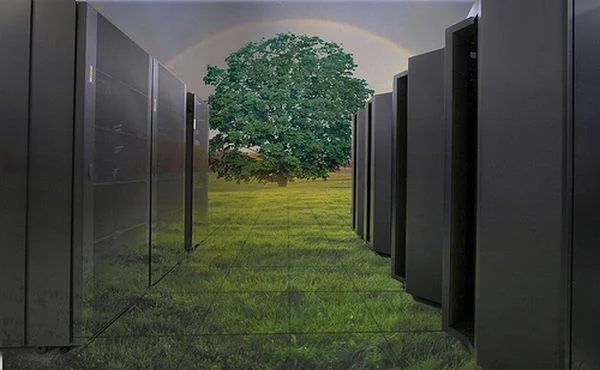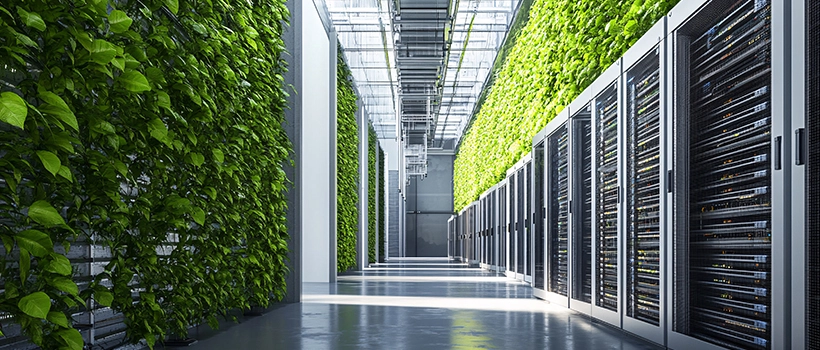Data centers power the digital world, and help us manage everything in online companies. But what about the cost? Their environmental impact is now a growing concern. These facilities consume vast amounts of energy, generate heat, and require significant water resources for cooling.
As demand for data increases, so does their contribution to carbon emissions and ecological strain. Understanding Data Center Environmental Pollution is crucial for developing sustainable practices and technologies to minimize harm. In this article of Danacloud, we’ll explore how data centers affect the environment, from energy usage to waste production, and discuss innovative solutions to create greener, more efficient systems that balance technological growth with ecological responsibility.
Here is a table summarizing the environmental impact of data centers and ways to reduce it:
| Environmental Impact | Description | Sustainable Practices to Mitigate Impact |
|---|---|---|
| 1. Energy Consumption | Data centers account for 1-2% of global electricity use, with hyperscale centers consuming as much as small cities. | Energy efficiency: Implement advanced cooling systems and optimize server utilization. Renewable energy: Transition to solar or wind power. |
| 2. Carbon Emissions | Data centers produced 200 million metric tons of CO₂ annually in 2022, contributing to climate change. | Renewable energy adoption: Use renewable sources like wind or solar. Energy-efficient equipment: Optimize operations to reduce emissions. |
| 3. Water Usage | Cooling systems consume large quantities of water, exacerbating local resource scarcity, especially in water-stressed regions. | Water conservation: Use liquid cooling or air-free cooling systems to minimize water use. Closed-loop systems: Recycle water. |
| 4. E-Waste | Servers and hardware replacement generate significant electronic waste, with toxic materials harming the environment. | E-Waste management: Prioritize reuse, repair, and recycling of IT equipment to reduce waste. |
| 5. Land Use | Large data centers occupy vast areas of land, impacting local ecosystems and potentially disrupting habitats. | Efficient land use: Build vertically or in urban areas to reduce land footprint. Environmental impact assessments during construction. |
| 6. Heat Generation | Data centers produce significant waste heat, which, if not managed, increases the need for cooling and contributes to energy consumption. | Heat reuse: Use waste heat for district heating or industrial applications to improve energy efficiency. |
Recent Statistics on Data Center Environmental Impact
| Impact | Statistic |
|---|---|
| Energy Consumption | In 2023, global data centers consumed 352 TWh of electricity, projected to grow to 857 TWh by 2028. |
| Carbon Emissions | Data centers are responsible for about 1% of energy-related greenhouse gas emissions. |
| Water Usage | Data centers in Virginia’s “Data Center Alley” consumed 1.85 billion US gallons of water in 2023. |
| Land Use | In Atlanta, data center expansion is encroaching on land that could be used for housing and retail. |
How to Lessen the Environmental Impact of Data Centers
| Sustainable Strategy | Action |
|---|---|
| Energy Efficiency | Use advanced cooling technologies, optimize server utilization, and energy-efficient equipment. |
| Renewable Energy | Transition to solar, wind, or other renewable energy sources to reduce reliance on fossil fuels. |
| Water Conservation | Adopt liquid cooling or air-free cooling systems to minimize water consumption. |
| E-Waste Management | Prioritize recycling of IT hardware, repair outdated systems, and adopt circular economy practices. |
| Heat Reuse | Utilize waste heat from data centers for district heating or other beneficial applications. |
What Are Data Centers and How Do They Work?
Data centers are specialized facilities that house servers, storage systems, and networking equipment to support businesses’ IT operations. They process, store, and transmit data, making them the backbone of the digital world. Here’s how they work:
- Infrastructure: Data centers consist of powerful hardware systems organized in racks, connected by high-speed networks to ensure seamless data flow.
- Power and Cooling: They require substantial energy for operation and cooling systems to prevent overheating, ensuring optimal performance.
- Redundancy: Backup power sources, such as generators and UPS systems, protect against outages, while redundant network connections ensure uninterrupted data accessibility.
- Security: Both physical security (restricted access, surveillance) and cybersecurity measures (firewalls, encryption) protect sensitive data.
Data centers are integral to everything from cloud computing to online banking, serving as critical hubs for storing and managing the information that drives modern technology.
Understanding the Environmental Impact of Data Centers
Data centers are “everything” when it comes to keeping data safe and managing operations. But one should not underestimate the impact they have on our mother earth. As demand for digital services increases, so does the strain on natural resources. Here’s a breakdown of their environmental impact:
- Energy Consumption: Data centers account for about 1-2% of global electricity use, with hyperscale centers consuming as much energy as small cities. Non-renewable energy sources often power these facilities, contributing to greenhouse gas emissions.
- Carbon Emissions: The carbon footprint of data centers is substantial. In 2022, global data centers were estimated to produce 200 million metric tons of CO₂ annually, and this number continues to grow without sustainable practices.
- Water Usage: Cooling systems, especially those reliant on water, consume billions of liters annually. In water-stressed regions, this can exacerbate local resource scarcity.
- E-Waste: As servers and hardware are replaced or upgraded, data centers generate significant electronic waste. Improper disposal can release we toxic materials into the environment.
- Land Use: Large data centers require substantial land, often disrupting local ecosystems during construction and operation.
Efforts are underway to mitigate these impacts. Renewable energy adoption is increasing, with many data centers now powered by solar or wind. Advanced cooling systems, like liquid or air-free cooling, reduce water usage. Additionally, circular economy practices, including hardware recycling and energy-efficient designs, are becoming industry standards.
Understanding the environmental consequences of data centers highlights the urgency for sustainable innovation. By prioritizing eco-friendly practices, the industry can balance digital growth with environmental stewardship, ensuring technology and nature can coexist in a rapidly evolving world.
How Bad Is It So Far?
Now that we talked about Data Center Environmental Pollution, lets read some recent statistics highlighting the extent of this matter:
- Energy Consumption: In 2023, global data centers consumed approximately 352 terawatt-hours (TWh) of electricity. This consumption is projected to grow at a compound annual growth rate (CAGR) of 19.5%, reaching 857 TWh by 2028.
- Carbon Emissions: Data centers and data transmission networks are responsible for about 1% of energy-related greenhouse gas emissions.
- Water Usage: In Virginia’s “Data Center Alley,” water consumption by data centers increased by nearly two-thirds from 2019 to 2023, with facilities consuming at least 1.85 billion US gallons in 2023.
- Land Use: The rapid expansion of data centers is leading to significant land use concerns. In Atlanta, for example, there is growing apprehension that data center development is encroaching on areas that could be used for housing and retail.
These figures underscore the pressing need for sustainable practices in data center operations to mitigate their environmental impact.
Read more: What is Data Center Security?
Is There a Way to Lessen the Impact?
Data centers can reduce their environmental impact through several sustainable practices:
- Energy Efficiency: Implementing advanced cooling technologies and optimizing server utilization can significantly lower energy consumption.
- Renewable Energy: Transitioning to renewable energy sources, such as solar or wind, can reduce carbon footprints.
- Water Conservation: Adopting innovative cooling methods that minimize water usage helps preserve local water resources.
- E-Waste Management: Prioritizing the reuse, repair, and recycling of IT equipment reduces electronic waste.
- Heat Reuse: Utilizing waste heat for district heating or other applications improves overall energy efficiency.
By embracing these strategies, data centers can operate more sustainably, balancing technological advancement with environmental responsibility.
Read more: What is a Data Center Rack?
Final Thoughts
The growing demand for digital services highlights the urgent need to address Data Center Environmental Pollution. From energy consumption to e-waste, data centers significantly impact the planet. However, adopting sustainable practices like renewable energy, efficient cooling, and waste management can mitigate their effects. By balancing technological advancement with environmental responsibility, we can ensure that data centers support innovation while safeguarding the planet for future generations.
FAQ
-
How do data centers contribute to climate change?
Data centers contribute to climate change through high energy consumption, often powered by fossil fuels, and significant carbon emissions from operations. Additionally, inefficient cooling systems and e-waste disposal practices further exacerbate their environmental impact.
-
Can smaller businesses reduce their data center footprint?
Yes, smaller businesses can opt for shared or cloud-based services, reducing the need for large on-premise setups. They can also prioritize energy-efficient equipment, virtualization, and renewable energy sources to minimize their environmental footprint.
-
Are there regulations for data center sustainability?
Several countries have introduced guidelines for data center energy efficiency and carbon reduction, such as the European Union’s Climate Neutral Data Centre Pact. These regulations encourage adopting renewable energy and eco-friendly practices industry-wide.


